Airline Amenity Kits
Elizabeth Arden loved to travel and when commercial air services were developed in the 1930s she “took to the air as if born with wings” (Lewis & Woodworth, 1973, p. 259). Her enthusiasm saw her endorse air travel in an ‘It Pays to Fly’ advertisement produced by the American air transport industry in 1939.
MISS ELIZABETH ARDEN, world’s foremost beauty authority and business woman: “I adore flying. In the course of a year, I fly at least 25,000 miles on business and pleasure. It’s a refuge from never ceasing telephones and as far as sleeping is concerned – it’s a cradle in the skies. The time saved enables me to do ever so much more work, and have more fun.”
(‘It Pays to Fly’ advertisement, 1939)
Given her love of flying, it is not surprising that Arden created an airline amenity kit. However, it was not the first product of its type. Lehn & Fink had put one together for United Airlines at least as early as 1937.
Lehn & Fink
United Airlines Skylounge Mainliners came with sleepers so male and female passengers were provided with a courtesy toilet kit. The women’s kit came with a Dorothy Gray cleanser, skin cream and face powder, a Tangee lipstick and a Pebeco tube of toothpaste, all products made by Lehn & Fink. The men’s kit came with Pinaud products and Pebeco toothpaste, again provided by Lehn & Fink (The Drug and Cosmetic Industry, 1937, p. 217)

Above: United Airlines stewardess puts together items for passenger comfort for an overnight flight. The Lehn & Fink courtesy cosmetics can be seen in the foreground.

Above: 1937 Split view of men’s and women’s washrooms aboard United Airlines Skylounge Mainliner. A courtesy toilet kit for women can be seen in the bottom right hand corner. An electrical socket meant that men could use an electric razor.
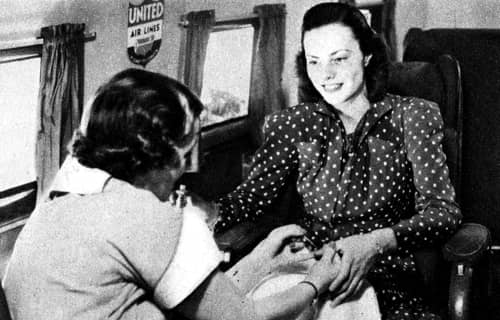
Above: 1937 Women who were prepared to pay for an extra seat could have an inflight beauty treatment. While it is unlikely that many woman were prepared to pay for this expensive service, it shows how serious United Airlines was in attracting women who made up to one-third of their passengers in 1936 (Rust, 2009, p. 144).
See also: Lehn & Fink
Elizabeth Arden
In 1949, Arden entered into an agreement with the British Overseas Airways Corporation (BOAC) – the precursor to British Airways – to supply an amenity kit for their Stratocruisers. Unlike the United Airlines kit, which appears to have been stocked with off-the-shelf items, many of the products in this Speedbird kit seem to have been specifically packaged for it.
Arden had been selling travel kits and beauty cases for decades but the cosmetics they contained were often packaged in glass, so travel kits and cases had to be very robust to avoid breaking the bottles and jars during travel. Switching to smaller, plastic containers meant that her Speedbird kits were lighter and more suited to air travel where weight restrictions applied.
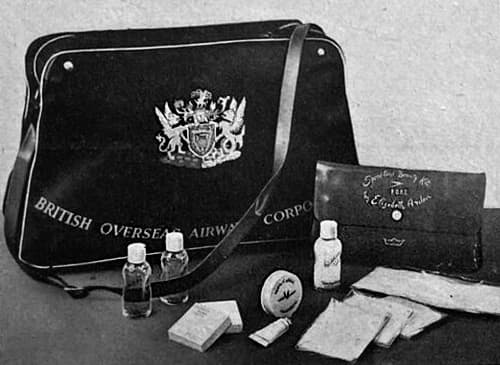
Above: 1950 Speedbird Beauty Kit included in a BOAC Overnight Bag.
The Speedbird name came from BOAC. It referred to the logo used on BOAC aircraft. They were supplied free of charge to women travelling on the BOAC Monarch service which operated daily between London and New York.

Above: BOAC Monarch service using Boeing 377 Stratocruisers with the Speedbird logo in the tail of the aircraft in front of the flag.
It’s the last word in luxury air travel!
Relax in the double-decked spaciousness of a pressurized Stratocruiser Speedbird … meet congenial companions in the lower-deck lounge with its well-stocked bar. Three stewards and a stewardess constantly study to please you.
Enjoy cocktails, a seven-course dinner with wine or champagne, then liqueurs … all served with the compliments of B.O.A.C. Finally, you may retire to the privacy of a comfortable full-size berth (only £8.19.0 extra). Breakfast in bed, if you wish.
Complimentary “Speedbird Overnight Bag” for every passenger … every lady receives a Speedbird Beauty Kit especially created by Elizabeth Arden. Yet, you pay no surcharge to travel by this luxurious new overnight service to New York—not a penny extra!(BOAC advertisment, 1951)
Speedbird Kits may also have been used on the ill-fated De Havilland DH-106 Comets that BOAC began operating in 1952. However, photographic evidence suggests that BOAC stocked a small range of Arden products in the powder room of these aircraft so the amenity kits may have been dispensed with.

Above: Arden products in a powder room of a BOAC Comet.
The cosmetics in the Speedbird Kits were not restricted to BOAC and women could purchase an Arden Beauty Kit or Sun Kit from department stores for US$2.50 and use them when travelling on other airlines. They came in two forms: one for general air travel; the other for passengers going to warmer, sunnier climates.
Speedbird Beauty Kit: Milky Liquid Cleanser, Velva Cream, Skin Lotion, Illusion Powder, Blue Grass Flower Mist, Superfine Toothpaste, Toothbrush, Tissues and Pads.
Speedbird Sun Kit: Fluffy Cleansing Cream, Skin Lotion, Pat-A-Crème, Illusion Powder, Blue Grass Flower Mist, 8-Hour Cream, Suntan Oil, Sun-Pruf Cream, and Tissues and Pads.
Arden advertised both lines well into 1951 but they seem to have disappeared after that, replaced by a number of other travel kits designed specifically for use in air travel.
Airline amenity kits went on to be introduced by other airlines and, until the introduction of budget carriers, were found on many domestic and most international flights.
First Posted: 26th July 2016
Last Update: 13th March 2022
Sources
The drug and cosmetic industry. (1937). 40. New York: Harcourt Brace Jovanovich.
Lewis, A. A., & Woodworth, C. (1973). Miss Elizabeth Arden an unretouched portrait. London: W. H. Allen.
Rust, D. L. (2009). Flying Across America: The airline passenger experience. Norman, OK: University of Oklahoma Press.

1939 Air Transport Industry ‘It pays to fly’ advertisement with Elizabeth Arden (centre top) endorsement (LIFE).
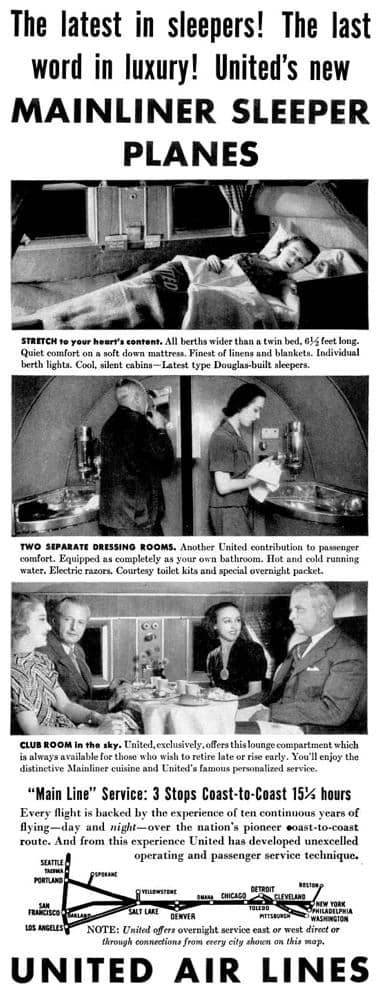
1937 United Airlines Skylounge Mainliner service.
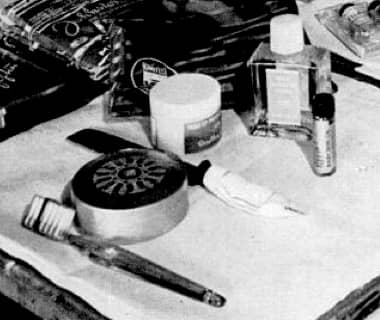
Close view of the cosmetics in the United Airlines Courtesy Kit containing Pebeco, Dorothy Gray and Tangee products all made by Lehn & Fink.
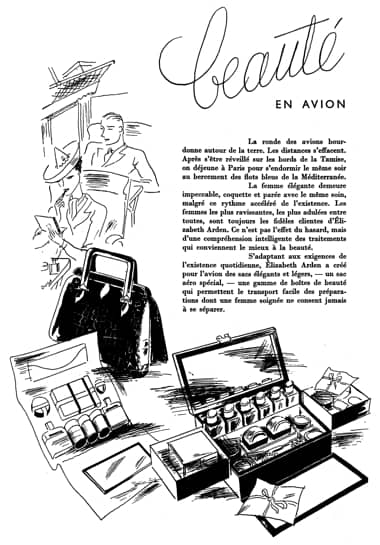
1938 Elizabeth Arden Airline Travel Cases (France).
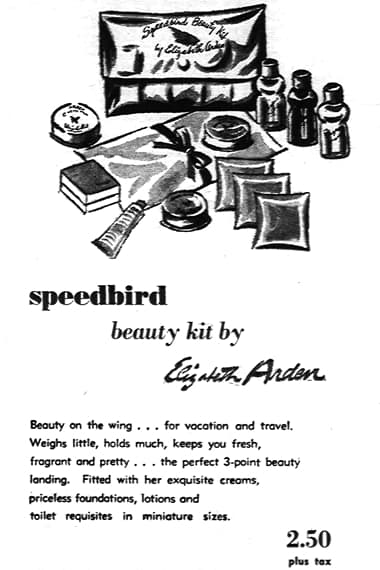
1949 Elizabeth Arden Speedbird Beauty Kit and Speedbird Sun Kit.
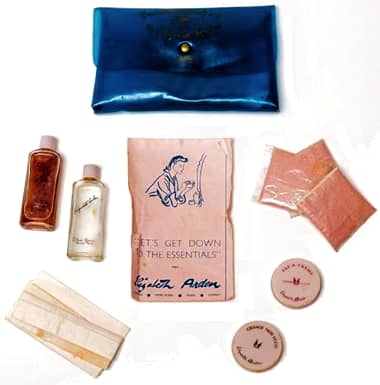
Speedbird Beauty Kit (Auckland Museum).
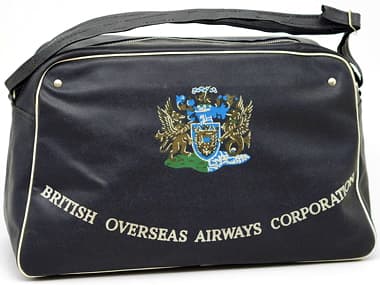
BOAC Speedbird Overnight Bag
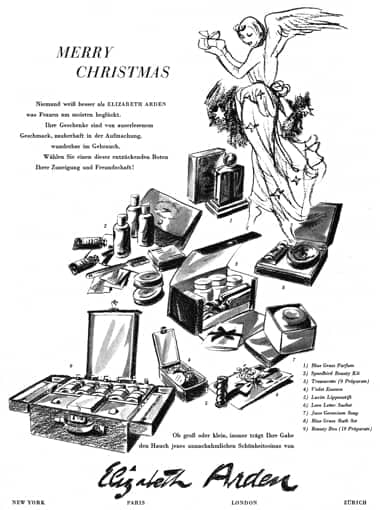
1949 Elizabeth Arden Beauty Kits including Speedbird.
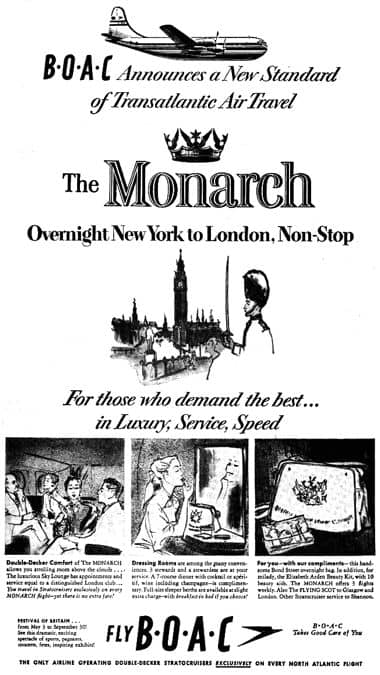
1951 BOAC Transatlantic Air Travel advertisement featuring an Elizabeth Arden Beauty Kit.
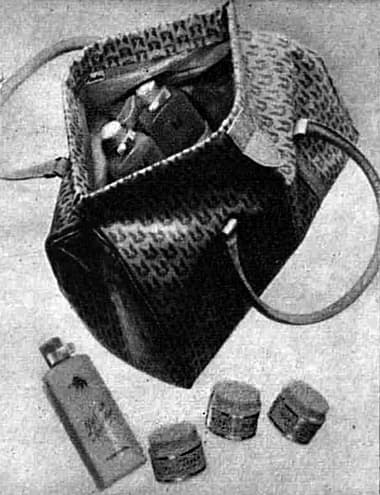
1953 Elizabeth Arden lightweight Travel Bag.
